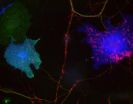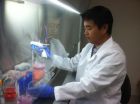Dual-hormone artificial pancreas is a step closer for patients with Type 1 diabetes
Randomized trial shows improved glucose levels, lower risk of hypoglycemia
2013-01-28
(Press-News.org) For patients with type 1 diabetes, a dual-hormone artificial pancreas system (also known as a closed-loop delivery system) improved the control of glucose levels and reduced the risk of hypoglycemia compared with conventional pump treatment in a trial published in CMAJ (Canadian Medical Association Journal).
It is challenging for patients with type 1 diabetes to control their glucose levels because tight glucose control increases the incidence of hypoglycemia (dangerously low glucose levels). Insulin pump treatment, which provides a continuous predetermined subcutaneous supply of insulin, is available, but hypoglycemia still occurs.
"Hypoglycemia is feared by most patients and remains the most common adverse effect of insulin therapy," writes Ahmad Haidar, Institut de Recherches Cliniques de Montréal and McGill University, with coauthors.
The dual-hormone artificial pancreas delivers insulin and glucagon using infusion pumps based on continuous glucose sensor readings as guided by an intelligent dosing algorithm. The infusion pumps and the glucose sensors are already on the market, but the intelligent algorithm was developed by the researchers in Montreal.
Researchers sought to assess the ability of the artificial pancreas to improve glucose control and reduce the possibility of hypoglycemia in adults with type 1 diabetes. They conducted a trial with 15 adult patients who had been using an insulin pump for at least 3 months. Patients were admitted to a clinical research facility for 2 15-hour experiments, and their glucose levels were controlled in 1 visit using the artificial pancreas system and the other visit using conventional pump treatment. On each visit, the patients exercised on a stationary bike, received an evening meal and a bedtime snack, and stayed in the facility until the next morning.
With the artificial pancreas system, participants' glucose levels were in the target zone 71% of the time compared to 57% with the conventional pump treatment. The artificial pancreas resulted in a 20-fold reduction in the number of night-time glucose measurements in the low glucose level range.
"[The dual-hormone artificial pancreas] improved glucose control and reduced the risk of hypoglycemia in our 15 participants, as compared with continuous subcutaneous insulin infusion," write the authors. "Rates of hypoglycemia were reduced, with no increased risk of hyperglycemia."
"Closed-loop delivery systems have the potential to substantially improve the management of diabetes and the safety of patients. These systems will probably be introduced gradually to clinical practice, with early generations focusing on overnight glucose control and using insulin alone," conclude the authors.
In a related commentary, Drs. David Nathan and Steven Russell, Massachusetts General Hospital, Harvard Medical School, write "Although [this] study is neither the first nor the longest investigation using a dual-hormone artificial pancreas, it is the first to compare such an apparatus to conventional intensive therapy in a randomized design. Treatment with the artificial pancreas increased the amount of time patients spent in the target range of blood glucose levels and decreased hypoglycemia. Thus, Haidar and colleagues show that low doses of glucagon administered under the control of a computer algorithm can act as a counter-regulatory hormone, preventing glucose levels from falling too low."
INFORMATION: END
ELSE PRESS RELEASES FROM THIS DATE:
2013-01-28
A new study of randomized clinical trials found significant observer bias toward a more beneficial treatment effect in nonblinded trials when the researcher knew the treatment being given to the participant. The study is published in CMAJ (Canadian Medical Association Journal).
"Nonblinded assessors of subjective measurement scales outcomes in randomized clinical trials tended to generate substantially biased effect sizes," writes Dr. Asbjørn Hróbjartsson, The Nordic Cochrane Centre, Rigshospitalet Department, Copenhagen, Denmark, with coauthors.
Danish and French researchers ...
2013-01-28
PORTLAND, Ore., January 28, 2013—For people with diabetes, meeting the recommended guidelines for blood pressure and cholesterol is even more important than meeting the guidelines for blood sugar control in reducing the risk of heart attack or stroke, according to a new Kaiser Permanente study published today in the Journal of General Internal Medicine.
The study included more than 26,000 patients with diabetes. Patients who met guidelines for all three risk factors and those who met the blood pressure and cholesterol guidelines were least likely to be hospitalized for ...
2013-01-28
For seniors who are constipated, the use of polyethylene glycol and lactulose are effective, according to a review of current treatments published in CMAJ (Canadian Medical Association Journal). The article reviews the latest evidence on the efficacy and safety of treatments to help doctors treat their patients.
Constipation, which increases with age, is a common complaint in seniors that can have serious health consequences and affect quality of life. Excessive straining in frail people can cause fainting and the risk of injury from falling or restrict blood flow to ...
2013-01-28
Japanese researchers show for the first time that primates modify their body movements to be in tune with others, just like humans do. Humans unconsciously modify their movements to be in synchrony with their peers. For example, we adapt our pace to walk in step or clap in unison at the end of a concert. This phenomenon is thought to reflect bonding and facilitate human interaction. Researchers from the RIKEN Brain Science Institute report today that pairs of macaque monkeys also spontaneously coordinate their movements to reach synchrony.
This research opens the door ...
2013-01-28
GRAFTON, Mass. (January 28, 2013)—A popular dog treat could be adding more calories than pet owners realize, and possibly be contaminated by bacteria, according to a study published this month by researchers at the Cummings School of Veterinary Medicine at Tufts University and the University of Guelph.
The treat in question: the "bully" or "pizzle stick." The American and Canadian researchers analyzed the caloric density and bacterial contamination of these popular items, made from the uncooked, dried penis of a bull or steer. They also administered a survey to pet owners ...
2013-01-28
Synapse development is promoted by a variety of cell adhesion molecules that connect neurons and organize synaptic proteins. Many of these adhesion molecules are linked to neurodevelopmental disorders; mutations in neuroligin and neurexin proteins, for example, are associated with autism and schizophrenia. According to a study in The Journal of Cell Biology, another family of proteins linked to these disorders regulates the function of neuroligins and neurexins in order to suppress the development of inhibitory synapses.
Like neurexins and neuroligins, the neuronal proteins ...
2013-01-28
Just as the body can become resistant to antibiotics, certain methods of killing cancer tumors can end up creating resistant tumor cells. But a University of Central Florida professor has found a protein present in several types of cancer, including breast and ovarian cancer, which could be helpful in preventing tumors from coming back.
The protein, KLF8, appears to protect tumor cells from drugs aimed at killing them and even aid the tumor cells' ability to regenerate.
"All cells have a DNA-repair mechanism," explained Jihe Zhao, a medical doctor and researcher who ...
2013-01-28
Hyderabad, India, and Shenzhen, China (28 January 2013) – In a scientific breakthrough that promises improved grain yields and quality, greater drought tolerance and disease resistance, and enhanced genetic diversity, a global research team has completed high-quality sequencing of not one but ninety genomes of chickpea.
Nature Biotechnology, the highest ranked journal in the area of biotechnology, featured the reference genome of the CDC Frontier chickpea variety and genome sequence of 90 cultivated and wild genotypes from 10 different countries, as an online publication ...
2013-01-28
Sophia Antipolis, 28 January 2013: The radial approach for percutaneous coronary interventions (PCI) was developed 20 years ago and is used for more than 50% of procedures in France, Scandinavian countries, the UK, Spain and Italy. Despite the advantages of radial access some countries in Europe such as Germany use radial access for fewer than 10% of PCI.
Evidence has accumulated in the literature showing the benefits of radial over femoral access for PCI including reduced bleeding and improved survival. In addition, the development of smaller and thinner devices has ...
2013-01-28
ANN ARBOR, Mich. — When researchers sequence the RNA of cancer cells, they can compare it to normal cells and see where there is more RNA. That can help lead them to the gene or protein that might be triggering the cancer.
But other than spotting a few known instigators, what does it mean? Is there more RNA because it's synthesizing too quickly or because it's not degrading fast enough? What part of the biological equilibrium is off?
After more than a decade of work, researchers at the University of Michigan Comprehensive Cancer Center have developed a technique to ...
LAST 30 PRESS RELEASES:
[Press-News.org] Dual-hormone artificial pancreas is a step closer for patients with Type 1 diabetes
Randomized trial shows improved glucose levels, lower risk of hypoglycemia


